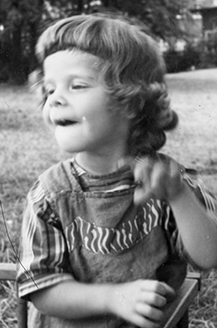Search for Names, Places and Biographies
Already layed Stumbling Stones
Suche
Lilli Brathauer * 1929
Wandsbeker Chaussee 257 (Wandsbek, Eilbek)
HIER WOHNTE
LILLI BRATHAUER
JG. 1929
EINGEWIESEN 1931
ALSTERDORFER ANSTALTEN
"VERLEGT" 1943
HEILANSTALT
AM STEINHOF WIEN
TOT 7.6.1944
Lilli Brathauer, born on 11 Dec.1929 in Hamburg, killed on 7 June1944 in the mental hospital Wagner von Jauregg-Heil- und Pflegeanstalt in Vienna
Wandsbeker Chaussee 257
"The mother makes a friendly, but slightly upset impression. She is struggling with the upbringing of the four children, is supported by the Winter Relief (Winterhilfe), the National Socialist People’s Welfare (Nationalsozialistische Volkswohlfahrt, NSV), and by the social service.” Indicating that Dora Brathauer was heavily burdened with the children, her request in May 1934 to take home her daughter Lilli – if only for a holiday or on approbation - was rejected. Dora Brathauer, neé Beyer, born in 1906 was married to the worker Philipp Brathauer, born in 1902 in Bremen. Both were living in Eilbek, Hammer Steindamm 36, when they married in 1925. In close succession two sons and two daughters were born; Lilli was the fourth child. She was followed by another sister five years later. In the meantime the family had moved to Wandsbeker Chaussee 257.
When Lilli was five weeks old her mother noticed that she hardly reacted to her environment. This was, however, not the reason why she was taken to the hospital in Barmbek by the end of Jan. 1930, but because a liquid secretion ran out of her left ear. Barely having returned home, she was readmitted to hospital because she suffered from skin eczema. A dietary change improved her situation. After a third stay in hospital in that year Lilli was released as cured. She was baptized on Easter 1931 in the Friedenskirche in Eilbek. Her behavioural disorder increased and she was institutionalized to the mental hospital then called Alsterdorfer Anstalten on 18 Dec. 1931 as a two year old child. One reason for her situation was Hypothyroidism. When this was treated, Lilli recovered immensely and made remarkable developmental improvements: she answered to her name, she noticed what happened in her environment, she sat and stood on her own; at times she reacted stubbornly.
Lilli moved only crawling and managed to stand up holding on the bars of her playyard, but she never learnt to walk. Her language remained limited, too, after her first word had been "Papa”. In June 1932 she suffered from a cramp for the first time. In summer 1933 she spent some free days with her family. The holidays did her well, but she had lice after her stay so her hair was cut when she returned to Alsterdorf. Lilli continued to have nutritional disorders and remained very weak. When she went to the garden she livened up and became cheerful.
In Aug. 1934 - three months after the request had been rejected for the first time - Lilli could go home on approbation. The burden on her mother – with three children and a baby – was, however, too great and Lilli was returned to Alsterdorf. There she attended infant school in 1935. In the two years to follow she came down with various infections, but seemed generally happy and satisfied.
A medical estimate of hereditary diseases (Erbgesundheitsgutachten) was rendered for the family. It stated a "family history" for the two sons. Lilli’s brothers attended the Hilfsschule
and wanted to join the German Youth (Jungvolk), but were rejected based on this estimate. Lilli’s illnesses and disabilities – among others a left sided hemiplegia – were ascribed to be the result of a non-congenital brain damage.
Lilli was considered "ineducable”. The generally friendly child became an occasionally stubborn girl who began to rip clothes and linen. On these occasions she was put into a straightjacket. The fact that she was so hot tempered may have been the reason why she was moved to the mental hospital Wagner von Jauregg-Heil- und Pflegeanstalt in Vienna together with 227 girls and women in Aug. 1943. The doctor receiving her registered her loud, inarticulate voice, that she was "not yet clean”, and a weight of 31 kg. Lilli’s body did not accept anything but milk soup. In the first four months of her stay in Vienna she lost another four kg. No record was kept for the time afterwards. When she died on 7 June 1944, tuberculosis, peptic ulcer, beginnings of an acute abdomen as well as emaciation were indicated as causes of death. Lilli Brathauer was 14 years old.
latest state: Feb. 2014
Translator: Paula Antonella Oppermann
Kindly supported by the Hermann Reemtsma Stiftung, Hamburg.
© Hildegard Thevs
Quellen: Ev. Stiftung Alsterdorf, Archiv, V 374; StaH 332-5 Standesämter 6643-210/1925; Jenner, Meldebögen, in: Wunder/Genkel/Jenner, Auf dieser schiefen Ebene; Wunder, Abtransporte, in: Wunder/Genkel/ Jenner, Auf dieser schiefen Ebene; ders., Exodus, ebd.


